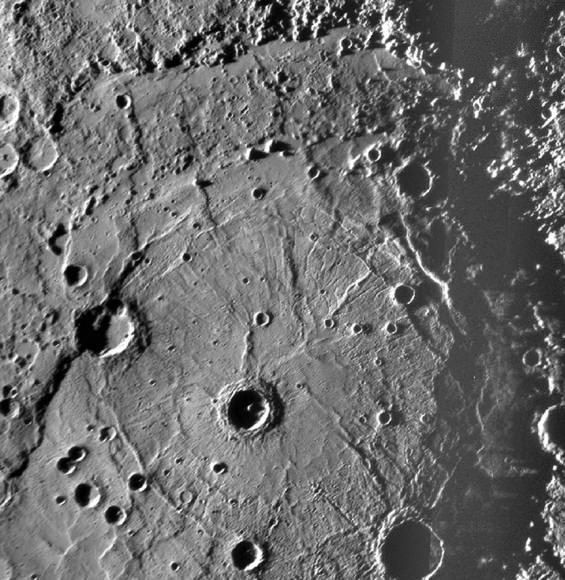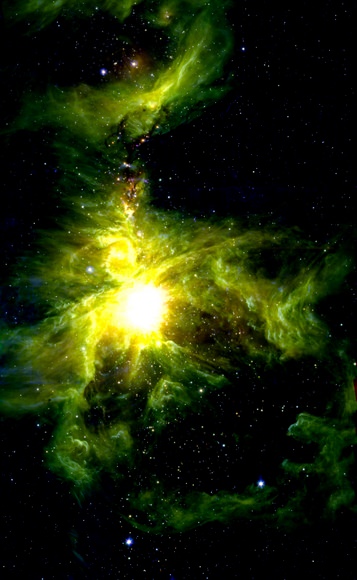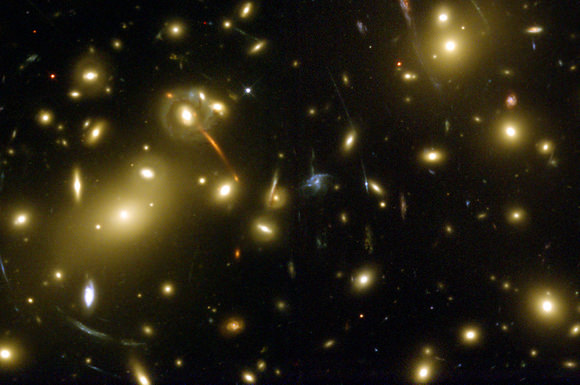Weekend SkyWatcher’s Forecast - May 1-3, 2009
 Greetings, fellow StarGazers! Let’s start the weekend off right by taking on a lunar club challenge and then kicking back to enjoy yet another spring meteor shower! (After all, if April showers bring May flowers, you do know what May flowers bring, don’t you? That’s right… Pilgrims!) Now that I’ve got you at least smiling, take out your binoculars, too… Because there’s two asteroids that are ripe for plucking - Hebe and Ceres. If you feel like being a little more serious about your lunar studies, why not do a little photographic map work? Just match the picture to what you see in the eyepiece and log your studies! Are you ready? Then I’ll see you in the back yard… (...)
Greetings, fellow StarGazers! Let’s start the weekend off right by taking on a lunar club challenge and then kicking back to enjoy yet another spring meteor shower! (After all, if April showers bring May flowers, you do know what May flowers bring, don’t you? That’s right… Pilgrims!) Now that I’ve got you at least smiling, take out your binoculars, too… Because there’s two asteroids that are ripe for plucking - Hebe and Ceres. If you feel like being a little more serious about your lunar studies, why not do a little photographic map work? Just match the picture to what you see in the eyepiece and log your studies! Are you ready? Then I’ll see you in the back yard… (...)
Read the rest of Weekend SkyWatcher’s Forecast - May 1-3, 2009 (845 words)
Starbursts from Dwarf Galaxies Like Fireworks

Fireworks in space? Astronomers are comparing “starbursts” from a galaxy that is in the throes of star formation to a Fourth of July fireworks display. And three particular galaxies are like my children’s favorite part of a fireworks display: the grand finale. These bursts occur at a fast and furious pace, lighting up a region for a short time before winking out. But that’s only part of the story. Archived data from the Hubble Space Telescope are showing that starbursts — intense regions of star formation — sweep across the whole galaxy and last 100 times longer than astronomers thought. The longer duration may affect how dwarf galaxies change over time, and therefore may shed light on galaxy evolution.
(...)
Read the rest of Starbursts from Dwarf Galaxies Like Fireworks (613 words)
New Mysteries Unveiled on Mercury

Even though Mercury looks like the Moon at first glance, scientists from the MESSENGER mission say it’s becoming apparent that Mercury is an amazingly dynamic planet, and is actually more like Mars. For example, before this mission, scientists weren’t sure if volcanism even existed on Mercury, but from the spacecraft’s two flybys, they now know it is a very important part of the planet’s history. Additional new findings from the second flyby of Mercury in October 2008 show that the planet’s atmosphere, magnetosphere, and geological past are all characterized by much greater levels of activity than scientists first suspected.
And by the way, isn’t this a stunning picture of an impact basin? It’s one of the new discoveries from MESSENGER.
(...)
Read the rest of New Mysteries Unveiled on Mercury (651 words)
Portal to the Universe Now Open
If you like RSS feeds, readers or other news aggregators, there’s a new website available that focuses on astronomy and space news. Called Portal to the Universe, it is the latest Cornerstone project of the International Year of Astronomy 2009 (IYA2009). Universe Today is one of the sites featured, and PTTU includes other news sites, blogs, video podcasts, audio podcasts, images, videos, and more. Don’t worry: PTTU isn’t trying to replace Universe Today or any other sites or blogs. The goal of this new site is to get the word out on what is being featured on all the different space and astronomy sites and push more readers their way. It’s all about community.
(...)
Read the rest of Portal to the Universe Now Open (211 words)
Latest from Saturn: Pastel Rings and Moons by the Bunch

The latest images from the Cassini spacecraft include this gorgeous natural color view of Saturn’s inner rings. Visible are the different degrees of transparency of the rings, which appear almost pastel in color. The dark shadows of the rings separate Saturn’s southern hemisphere in the bottom of the image from the north. The innermost D ring is invisible, laid over the planet’s northern hemisphere. The translucent C ring runs through the middle of the image. The denser B ring stretches across the top of the image. See below for more info on this image, as well as a challenge to “find the moons” on another Cassini image.
(...)
Read the rest of Latest from Saturn: Pastel Rings and Moons by the Bunch (260 words)
The Blurry Summit of Mars’ Pavonis Mons
This strange image was captured by the High Resolution Imaging Science Experiment (HiRISE) camera on board NASA’s Mars Reconnaissance Orbiter (MRO) on April 11th. At first it looked like a classic example of my early camera days without a tripod; most of the photos I took were blurry or out of focus (due to my less-than-perfect eyesight). So when I first saw this picture of the summit of one of the huge Martian ex-shield volcanoes, Pavonis Mons, I assumed it was a mistake; HiRISE either had the shakes or it had developed myopia.
Actually, this image is in focus, HiRISE is working perfectly. It’s the Martian surface that’s blurry…
(...)
Read the rest of The Blurry Summit of Mars’ Pavonis Mons (270 words)
Mars Express Spies Rocky, Chaotic Terrain on Mars
Wow – what a shot by Mars Express! Mars has several regions of what is called ‘chaotic terrain’. These are areas with large accumulations of rocks of varying sizes, as well as flat-topped features. These erratically shaped rocks are large, too: between 1-10 km in size. Some chaotic terrain on Mars is thought to form when there is a sudden removal of subsurface water or ice, causing the surface material to slump and break into blocks. The region shown here, however — Ariadnes Colles — is not a water-source region, so scientists are still debating whether Ariadnes Colles was formed by the action of water or wind. Either way, this is a very interesting region. See below for a straight on view that’s just as incredible.
(...)
Read the rest of Mars Express Spies Rocky, Chaotic Terrain on Mars (170 words)
Life Beyond Earth in 10 Years or Less?

Illustration credit: Robert McCall
Peter Smith feels pretty certain we’ll be finding life on Mars within the next decade.
Smith, the University of Arizona professor who led NASA’s Phoenix Mars Mission, made his predictions to a spellbound audience during a lecture at the University of Delaware earlier this month, and he discussed his ideas by phone on Thursday. He carries a “sense of optimism” about finding life on Mars, he said, because of the tantalizing clues Phoenix sent to Earth.
“Finding life on Mars would be one of the great discoveries of all time,” he said. “We’re not that far away. The next mission could be the one.”
(...)
Read the rest of Life Beyond Earth in 10 Years or Less? (593 words)
Shadows Helped Form the “Pillars of Creation”
How were the famous “Pillars of Creation” formed? Perhaps only the shadow knows! New research suggests that shadows hold the key to how giant star-forming structures like the “Pillars” in the Eagle Nebula take shape.
(...)
Read the rest of Shadows Helped Form the “Pillars of Creation” (465 words)
Dark Matter, Dark Energy; Now There’s “Dark Gulping”
For all you dark matter and dark energy fans out there, now there’s another new “dark” to add to the list. It’s called “dark gulping,” and it involves a process which may explain how supermassive black holes were able to form in the early universe. Astronomers from the University College of London (UCL) propose that dark gulping occurred when there were gravitational interactions between the invisible halo of dark matter in a cluster of galaxies and the gas embedded in the dark matter halo. This occurred when the Universe was less than a billion years old. They found that the interactions cause the dark matter to form a compact central mass, which can be gravitationally unstable, and collapse. The fast dynamical collapse is the dark gulping.
(...)
Read the rest of Dark Matter, Dark Energy; Now There’s “Dark Gulping” (470 words)
Mercury More Active than Scientists Thought
NASA Science News for April 30, 2009
A NASA spacecraft gliding over the surface of Mercury has revealed that the planet's atmosphere, magnetosphere, and its geological past display greater levels of activity than scientists first suspected.
FULL STORY at
http://science.nasa.gov/headlines/y2009/30apr_mercury.htm?list1035898
New Gamma-Ray Burst Smashes Cosmic Distance Record
NASA Science News for April 28, 2009
A gamma-ray burst detected by NASA's Swift satellite has smashed the previous distance record for the most powerful explosions in the Universe. Researchers are calling it "an incredible find" and a "true blast from the past."
FULL STORY at
http://science.nasa.gov/headlines/y2009/28apr_grbsmash.htm?list1035898
Weekend Sky Show
NASA Science News for April 24, 2009
On Sunday, April 26th, the crescent Moon, Mercury and the Pleiades star cluster will line up in the western sky for a beautiful sunset conjunction.
FULL STORY at
http://science.nasa.gov/headlines/y2009/24apr_eveningsky.htm?list1035898
Orion’s Belt Sees More Action Than We Knew

Using infrared telescopes, European and American astronomers have peered through the opaque molecular cloud that obscures much of Orion’s stellar nursery from view.
They’ve discovered a rowdy scene there — a crowded stellar nursery, with young stars shooting supersonic hydrogen jets in all directions — and they’re reporting there is much more going on in Orion than previously thought.
The new survey is the most wide-ranging census ever produced of dynamical star formation in and around the well-known Great Nebula of Orion.
(...)
Read the rest of Orion’s Belt Sees More Action Than We Knew (581 words)
NASA Science News for April 22, 2009
All research and no application makes data a dull toy. NASA's SPoRT program brings data to life by putting it in the hands of people who can use it best--the National Weather Service forecasters who send us scurrying for cover when severe weather looms.
FULL STORY at
http://science.nasa.gov/headlines/y2009/22apr_severeweather.htm?list1035898




